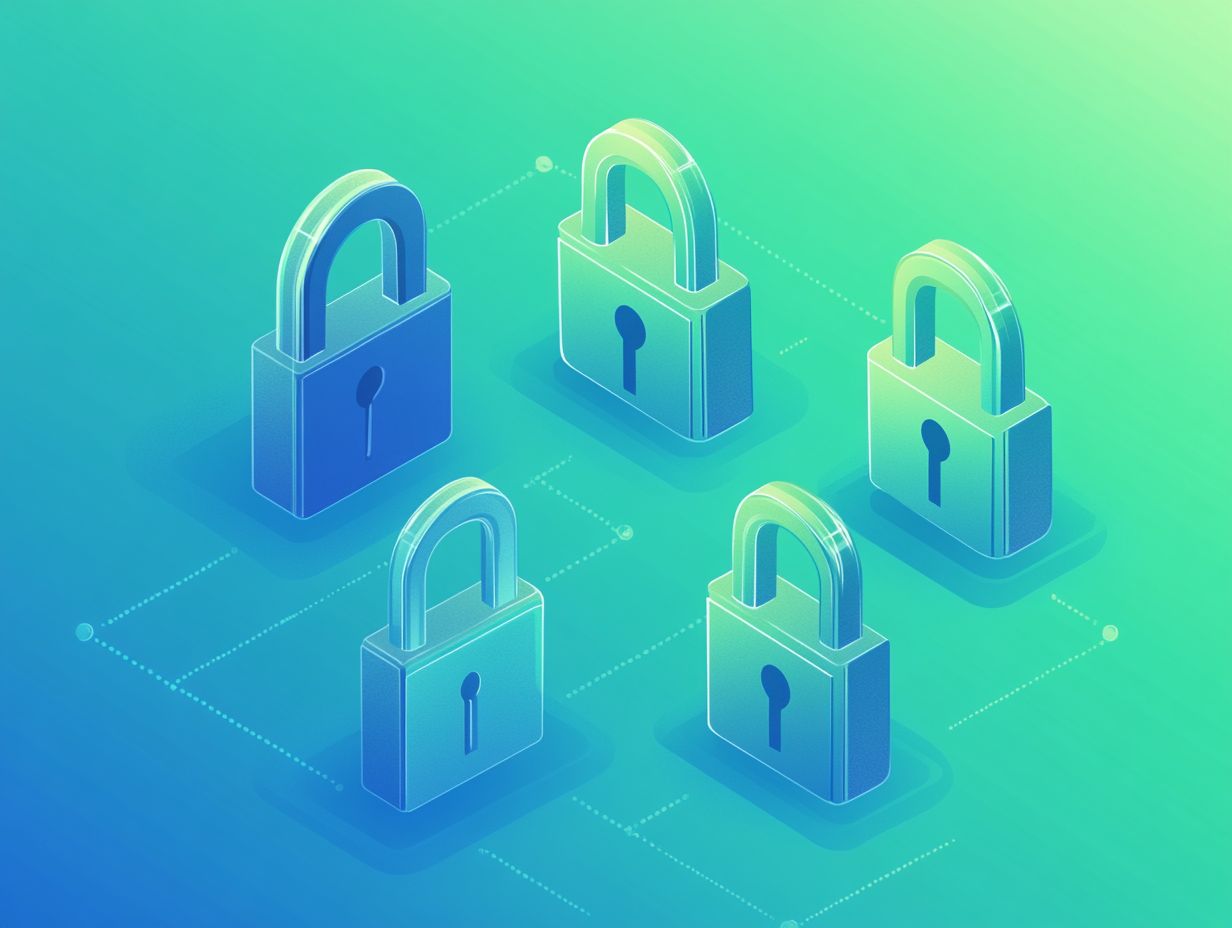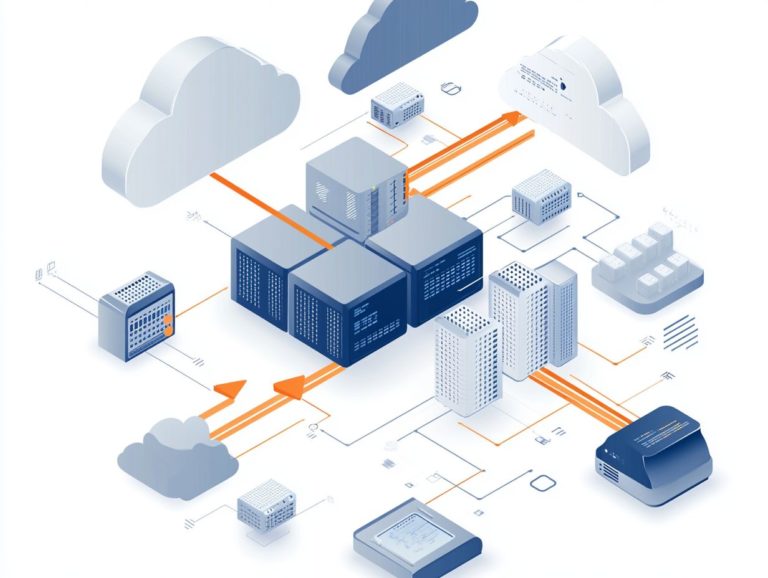5 Essential IaaS Security Features
In today s digital landscape, securing Infrastructure as a Service (IaaS) is vital for you as a business leader. Protecting your valuable data and operations should be a top priority.
This article discusses five essential security features that are key to a strong security plan for IaaS. From network security to data encryption, each component plays a critical role in defending against potential threats.
You can ensure your cloud environments remain resilient by understanding these elements and their benefits. Explore how to implement these security measures to safeguard your infrastructure effectively.
Contents
Key Takeaways:

Network security protects you from external threats and keeps unauthorized users out. Data encryption keeps sensitive information confidential while in transit and at rest. Identity and access management allows you to control and monitor user access to IaaS resources.
1. Network Security
Network security is a fundamental aspect of IaaS security, as it focuses on protecting your infrastructure from cyber threats. Understanding the features that differentiate cloud providers can also enhance your overall security strategy.
To defend against attacks like Distributed Denial of Service (DDoS) and malicious software bots, use a mix of firewalls, intrusion detection systems, and constant monitoring.
As your organization increasingly relies on remote resources, the importance of network security grows. Implementing advanced firewalls and intrusion detection systems is crucial. These tools serve as your first line of defense against unauthorized access.
Compliance regulations like ISO 27001 provide valuable frameworks for establishing security measures. Following best practices such as regular security audits, comprehensive employee training, and incident response planning strengthens your organization s security posture.
By prioritizing these elements, you can effectively protect your data and maintain customer trust in our evolving digital world.
2. Data Encryption
Data encryption is a cornerstone of security in IaaS environments. It protects your sensitive information using advanced techniques while ensuring compliance with regulations like GDPR and ISO 27001.
Methods such as Advanced Encryption Standard (AES), Rivest-Shamir-Adleman (RSA), and Secure Hash Algorithm (SHA) are essential for keeping your data safe from unauthorized access.
These techniques not only safeguard delicate information but also build customer trust and improve your organization s reputation.
To enhance your security further, adopt strong key management practices. This involves effectively generating, storing, and rotating encryption keys. By doing so, you can reduce the risks associated with lost or compromised keys, bolstering your overall data protection strategy.
3. Identity and Access Management

Identity and access management (IAM) is critical for securing your IaaS environment. It enables you to control user access and manage identities using effective authentication methods, including Multi-Factor Authentication (MFA). MFA is a security process that requires multiple forms of verification before granting access.
This approach not only protects your sensitive data but also significantly reduces the risk of breaches from unauthorized access. IAM systems use various models such as Role-Based Access Control (RBAC) and Attribute-Based Access Control (ABAC), ensuring individuals receive only the permissions necessary for their roles.
Continuous user education is essential to reinforce secure identity management practices. By updating users on potential threats and best practices, you can foster a culture of security awareness that significantly reduces risks related to identity theft and unauthorized access.
Don’t wait until it’s too late; implementing these security measures now can protect your business from future threats. Consider these 5 key considerations for cloud security architecture and start securing your IaaS environment today!
4. Vulnerability Management
Vulnerability management is essential for identifying and addressing software vulnerabilities within your IaaS environments. This proactive approach helps prevent security incidents through diligent patch management and regular vulnerability assessments.
This isn t just a one-off task; it s a commitment to continuous monitoring and assessment. Ensuring that any emerging threats are swiftly detected and mitigated is crucial.
Effective strategies for distributing patches are vital. You must implement robust procedures to ensure updates are applied promptly across all systems.
Take the infamous Equifax breach, which stemmed from a failure to patch known vulnerabilities in a timely manner. Create a culture of readiness to stay ahead of threats!
5. Disaster Recovery and Business Continuity
Disaster recovery and business continuity planning are vital aspects of IaaS security. They enable you to quickly restore operations and recover from data breaches or other security incidents through a well-crafted backup strategy.
Your plans must include essential practices, such as conducting regular risk assessments to identify potential vulnerabilities and threats that could disrupt your services.
A proactive approach not only involves establishing robust backup procedures but also entails regularly testing these systems to ensure they function as intended. Security measures are crucial for safeguarding data integrity and minimizing the repercussions of incidents like cyberattacks.
By weaving these key elements together, you can cultivate resilience within your organization, enabling you to navigate crises effectively and maintain trust with clients and stakeholders.
What Is IaaS and Why Is Security Important for It?

Infrastructure as a Service (IaaS) is a cloud computing model that provides virtualized computing resources via the internet. It offers benefits like scalability and cost-effectiveness, but it also requires robust cloud security measures to manage risks and understand the shared responsibilities between cloud providers and users.
This model allows quick provisioning of servers, storage, and networking components, letting you scale your infrastructure based on demand without significant upfront investments.
Unlike traditional on-premises solutions or other cloud service models like Platform as a Service (PaaS) and Software as a Service (SaaS), IaaS gives you more control and flexibility over your computing environment.
With this control comes the responsibility of establishing effective security protocols. You need to stay vigilant about potential vulnerabilities within the architecture. While providers focus on securing the infrastructure, securing applications and data largely rests on your shoulders. This highlights the importance of a collaborative security approach.
What Are the Key Components of IaaS Security?
The key components of IaaS security involve a comprehensive set of controls. These include network security measures, data encryption techniques, identity management protocols, and compliance with regulatory requirements. For enhanced protection, consider the 5 security features to look for in cloud storage. Together, these elements reinforce your infrastructure against potential threats.
Implementing robust network security measures effectively prevents unauthorized access and reduces the risks of data breaches. Utilizing data encryption techniques safeguards sensitive information both at rest and in transit, making it significantly harder for attackers to exploit vulnerabilities.
Effective identity management protocols are essential for regulating user access. They ensure that only authorized personnel can interact with critical systems. To strengthen your security strategies, comply with established frameworks like ISO 27001 or GDPR. This not only promotes best practices but also helps you meet legal obligations.
This commitment ultimately enhances your overall security posture and gives you peace of mind.
Regularly assess your IaaS security measures to stay ahead of emerging threats!
How Can IaaS Security Be Implemented in an Organization?
Implementing IaaS security in your organization requires a systematic approach. This involves crafting security strategies, adopting thorough steps, ensuring compliance certifications, and leveraging automated updates to maintain a strong security setup, including understanding the essential features of a cloud security solution.
Your journey begins with an initial assessment of the existing infrastructure. Here, you evaluate vulnerabilities and compliance requirements.
Once you’ve pinpointed potential weaknesses, the next step is to design a tailored security framework. This framework should include encryption, access controls, and monitoring tools.
With this framework established, it’s crucial to continually review and integrate best practices. These should encompass incident response protocols and data loss prevention strategies.
Automated updates for security software are essential in defending against evolving threats. Just as vital is fostering a culture of security awareness through ongoing training and user education, enabling your staff to recognize and effectively mitigate risks.
What Are the Common Threats to IaaS Security?

Common threats to IaaS security encompass data breaches, credential compromise, and sophisticated malware attacks. To effectively address these issues, it’s crucial to understand the 5 things to know before choosing IaaS, which call for your team to adopt vigilant malware protection and comprehensive security strategies to mitigate risks.
These threats are not only common but also increasingly sophisticated. They target vulnerabilities that can compromise sensitive data and disrupt your operations.
For example, a data breach could grant unauthorized access to customer information. This may lead to financial losses and tarnish your reputation.
Likewise, credential compromise can occur through phishing attacks. This allows malicious actors to gain access to users’ login details, potentially resulting in unauthorized usage of cloud resources.
To effectively combat such risks, here are key measures to implement:
- Multifactor authentication
- Regular security audits
- Employee training on recognizing phishing attempts
Employ advanced threat detection tools to identify and neutralize malware before it can cause harm.
How Can IaaS Security Be Continuously Monitored and Improved?
It’s vital to continuously monitor and improve your IaaS security. Employing techniques such as security audits, vulnerability management, and real-time monitoring, along with understanding the key features of a cloud security strategy, can enhance your organization’s overall security posture.
These actions not only react to threats but also spot weaknesses before they can be targeted. By implementing robust tools like SIEM solutions and conducting regular vulnerability assessments, you can gain valuable insights into your security environment.
Adopting best practices such as prioritizing critical assets and automating alerts will greatly improve how quickly you spot anomalies. As the landscape of cyber threats shifts, it s essential for you to remain agile, leveraging threat intelligence to inform your strategies and adjust your defenses.
This adaptive approach ensures that your security measures keep pace with emerging risks. Stay proactive and adapt your defenses to protect your organization from emerging threats.
What Are the Benefits of Investing in IaaS Security?
Investing in IaaS (Infrastructure as a Service) security offers a wealth of benefits. This includes enhanced threat detection and compliance with regulations, which supports your business growth and instills confidence in customers and stakeholders.
Prioritizing IaaS security protects your sensitive information and helps you meet industry standards. This proactive approach reduces the risk of data breaches and boosts your organization’s reputation, which is why developing essential skills for IaaS administrators is crucial.
With strong security measures, you foster customer trust. This nurtures long-term relationships essential for sustained success.
A solid security posture allows you to operate efficiently. You can focus on strategic initiatives instead of being bogged down by security issues.
In short, committing to IaaS security means investing in compliance and your business’s overall performance.
Frequently Asked Questions
What are the 5 Essential IaaS Security Features?
The 5 essential IaaS security features are multi-factor authentication, encryption, network security, access controls, and data backups.
Why is multi-factor authentication important for IaaS security?
Multi-factor authentication adds extra security. It requires users to provide two or more verification forms before accessing IaaS resources.
How does encryption enhance IaaS security?
Encryption converts plain text into unreadable code. This makes it nearly impossible for hackers to access sensitive information.
What is the role of network security in IaaS security?
Network security uses measures like firewalls and virtual private networks to safeguard IaaS resources from external threats. For those considering cloud solutions, understanding the 5 must-have features in cloud storage is crucial.
How do access controls contribute to IaaS security?
Access controls limit user permissions. This ensures only authorized individuals can access specific resources, preventing data breaches.
Why is it important to have data backups as an essential IaaS security feature?
Data backups allow recovery of lost or corrupted data. Regular backups help minimize the impact of security incidents.






